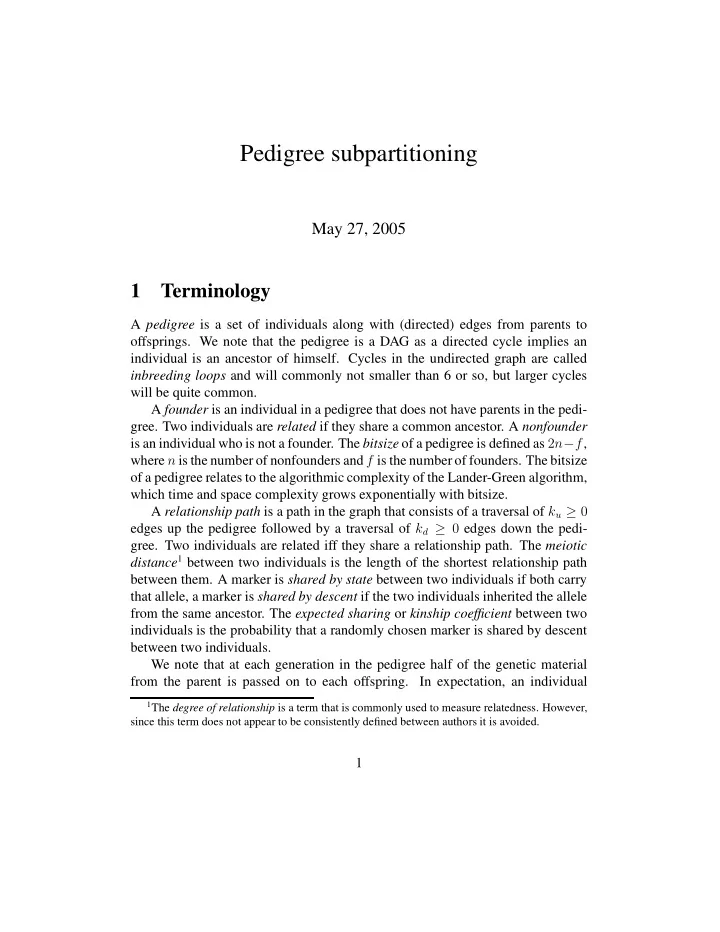

Pedigree subpartitioning May 27, 2005 1 Terminology A pedigree is a set of individuals along with (directed) edges from parents to offsprings. We note that the pedigree is a DAG as a directed cycle implies an individual is an ancestor of himself. Cycles in the undirected graph are called inbreeding loops and will commonly not smaller than 6 or so, but larger cycles will be quite common. A founder is an individual in a pedigree that does not have parents in the pedi- gree. Two individuals are related if they share a common ancestor. A nonfounder is an individual who is not a founder. The bitsize of a pedigree is defined as 2 n − f , where n is the number of nonfounders and f is the number of founders. The bitsize of a pedigree relates to the algorithmic complexity of the Lander-Green algorithm, which time and space complexity grows exponentially with bitsize. A relationship path is a path in the graph that consists of a traversal of k u ≥ 0 edges up the pedigree followed by a traversal of k d ≥ 0 edges down the pedi- gree. Two individuals are related iff they share a relationship path. The meiotic distance 1 between two individuals is the length of the shortest relationship path between them. A marker is shared by state between two individuals if both carry that allele, a marker is shared by descent if the two individuals inherited the allele from the same ancestor. The expected sharing or kinship coefficient between two individuals is the probability that a randomly chosen marker is shared by descent between two individuals. We note that at each generation in the pedigree half of the genetic material from the parent is passed on to each offspring. In expectation, an individual 1 The degree of relationship is a term that is commonly used to measure relatedness. However, since this term does not appear to be consistently defined between authors it is avoided. 1
will share 2 − k of the genetic material of a k -th generation ancestor. Similarly, individuals that have meiotic distance k will in expectation share 2 − k of the ge- netic material of the common ancestor that defines their shortest relationship path. Commonly, individuals will have multiple relationship paths. In particular, in monogomous pedigrees two related individual where one is not the ancestor of the other will have two equally long relationship paths via a male and a female ancestor. If their meiotic distance is k their expected sharing is at least 2 k − 1 . In pedigrees the kinship coefficient can be calculated as 2 − l ( R ) � κ ( a, b ) = All relationship paths R from a to b where l ( R ) is the length of a path. 2 We note that the shortest paths will contribute the most to this sum and we will make the approximation that the kinship coefficient is computed as: 2 − l ( R ) � κ ( a, b ) = All shortest relationship paths R from a to b The computation of κ is dependant on the pedigree we consider. When we construct subpedigrees and remove some of the relations between the individuals the computation of κ will be affected. To emphasize this we will use κ P ( a, b ) to indicate the kinship coefficient of a and b under the assumption the pedigree is P . An individual is either affected or not affected. The affected individuals are of greater interest to us than the nonaffected. Given a set I of individuals or pedigree P , α ( I ) , α ( P ) will denote the individuals in I, P that are affected. 2 Problem definition We can now describe the pedigree refinement problem. Problem 1 (Pedigree Refinement) Input A pedigree P and for each individual a boolean indicating whether or not the individual is affected and a constant C Output A set of subpedigrees P 1 , P 2 , ..., P k ⊂ P such that 2 I am not sure if this is true for certain inbread pedigrees, but let’s not worry about that for the time being. 2
c1 ∪ P i ⊂ P c2 | α ( P i ) ∩ α ( P j ) | ≤ 1 , ∀ i, j c3 bitsize ( P i ) ≤ C , C some fixed constant. Objective max � k a,b ∈ α ( P i ) κ P i ( a, b ) � i =1 3
Recommend
More recommend